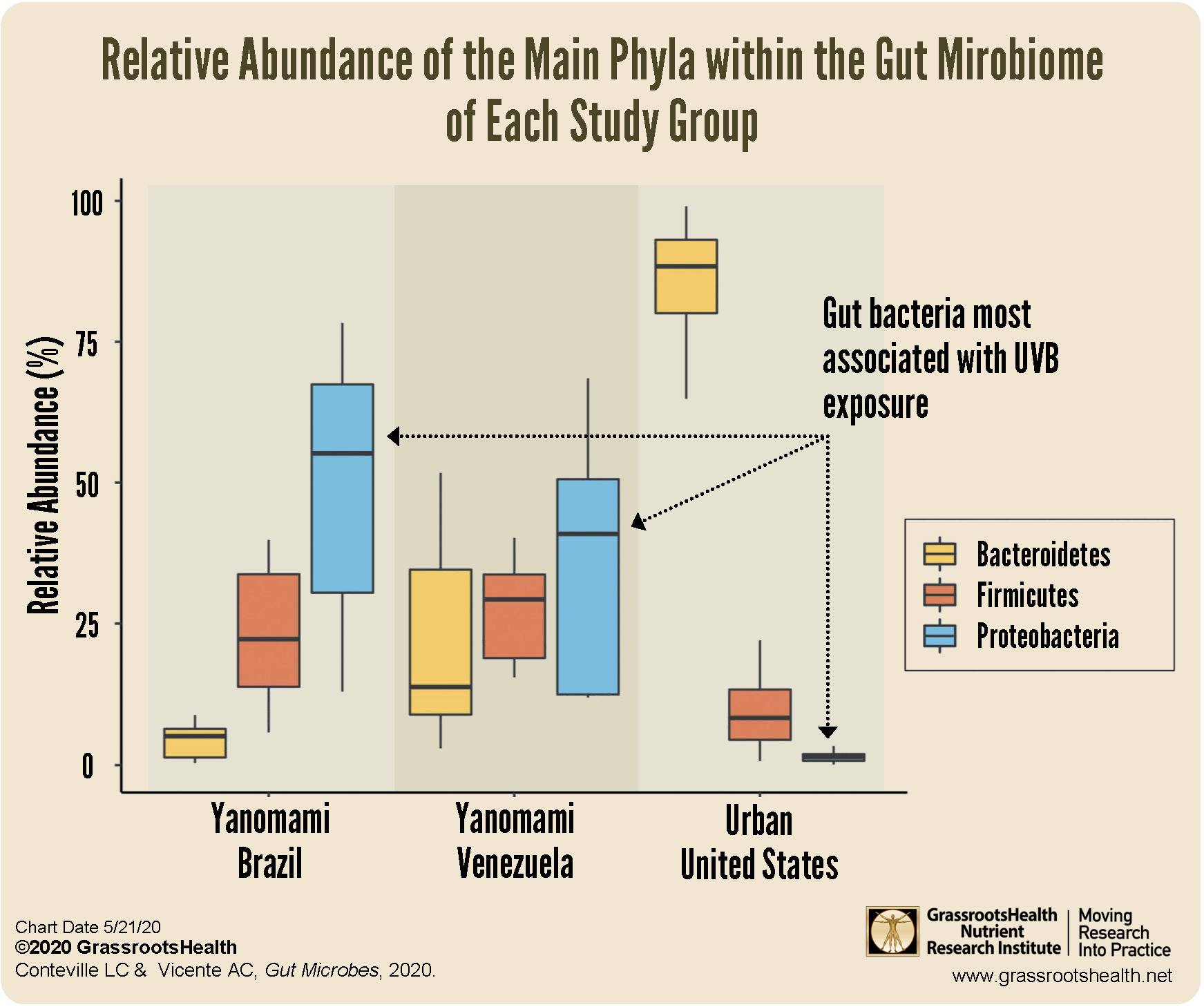Published on May 22, 2020
 A 2019 study by Bosman et al., highlighted in a previous GrassrootsHealth post, looked at the effects of narrow band UVB light therapy on the diversity of gut bacteria species. Participants were Caucasian, healthy, female, had a Fitzpatrick Skin Type of I, II or III, and were between the ages of 19 and 40 living in Vancouver, Canada. The study divided women into two groups – those who took vitamin D supplements during the preceding winter (starting vitamin D levels >75 nmol/L or 30 ng/ml) and those who did not (majority starting vitamin D levels between 25-75 nmol/L or 10-30 ng, ml). Results showed that several bacterial strains that are associated with a healthy gut microbiome were increased with vitamin D supplementation and UVB light therapy. Lachnospiraceae, a family of the Firmicutes bacteria phylum, increased the most, and its abundance is thought to be linked to the vitamin D status of the host.
A 2019 study by Bosman et al., highlighted in a previous GrassrootsHealth post, looked at the effects of narrow band UVB light therapy on the diversity of gut bacteria species. Participants were Caucasian, healthy, female, had a Fitzpatrick Skin Type of I, II or III, and were between the ages of 19 and 40 living in Vancouver, Canada. The study divided women into two groups – those who took vitamin D supplements during the preceding winter (starting vitamin D levels >75 nmol/L or 30 ng/ml) and those who did not (majority starting vitamin D levels between 25-75 nmol/L or 10-30 ng, ml). Results showed that several bacterial strains that are associated with a healthy gut microbiome were increased with vitamin D supplementation and UVB light therapy. Lachnospiraceae, a family of the Firmicutes bacteria phylum, increased the most, and its abundance is thought to be linked to the vitamin D status of the host.
Overall, the Bosman study showed that, among participants who did not supplement with vitamin D, and whose vitamin D levels were deficient, UVB exposure alone was able to improve the diversity of the gut microbiome and increase certain strains of bacteria known to be beneficial to human health.
UVB Exposure and vitamin D status plays a role in the diversity of gut bacteria species
 In a recently published paper, Conteville and Vicente (2020) discussed the microbiome of the Yanomami tribe, a group of approximately 35,000 hunter-gatherers indigenous to the Amazon 4°N of the equator, and compared their gut microbiome composition to the US population and the Bosman et al. study.
In a recently published paper, Conteville and Vicente (2020) discussed the microbiome of the Yanomami tribe, a group of approximately 35,000 hunter-gatherers indigenous to the Amazon 4°N of the equator, and compared their gut microbiome composition to the US population and the Bosman et al. study.
The geographical location of the Yanomami tribe exposes them to high levels of UVB sunlight which is associated with increased levels of vitamin D and increased diversity of beneficial bacteria species in the gut. Firmicutes and Proteobacteria bacteria species are highest in the Yanomami tribe due to their lifestyle, diet, and environment. These same species of bacteria increased after UVB light exposure in the Bosman study. The chart below looks at the diversity of three different bacteria species in the Yanomami tribes versus the United States population. As you can see, the United States microbiome has a high ratio of Bacteroidetes to Firmicutes which is related to poor gut health and exhibits less bacterial diversity than the Yanomami tribe.
The authors conclude, “Altogether, the association of UVB light with specific microbiome taxonomic profiles observed in distinct populations leads us to consider that UVB light/sunlight is a tangible factor that should be considered as a modulator of the gut microbiome.”
In conclusion, UVB light from the sun increases serum vitamin D levels and also has a beneficial impact on diversity and abundance of the bacteria species of the gut microbiome.
Does your gut need more sunshine and vitamin D?
This sunshine month, as always, it is important to remember that getting regular, proper sun exposure, without burning, is essential to good health – for reasons beyond vitamin D. However, it is still important to know what your vitamin D levels are; test today, and take the necessary steps to get your vitamin D level to your target range for health!
This Sunshine Month, get 10% off your home blood spot test kits PLUS the free Sunshine eBook when using the code SUNMONTH25 at checkout.
Do You Have Enough Vitamin D to Support a Healthy Immune System?
Do you know what your vitamin D level is? Be sure to test today to find out, and take steps to keep it within a target of 40-60 ng/ml or 100-150 nmol/L! Give your immune system the nutrients it needs to support a healthy you and protect yourself from unnecessary diseases.
Through GrassrootsHealth Nutrient Research Institute, you can also test your essential elements magnesium, copper, zinc and selenium, toxins such as lead, mercury and cadmium, as well as your omega-3 levels, inflammation levels and thyroid stimulating hormone (TSH) level. Find out your levels today! Log on to the test selection page (click the link below) to get your tests and see for yourself if your levels can be improved.
Make sure you track your results before and after, about every 6 months!
How can I track my nutrient intake and levels over time?
To help you track your supplement use and nutrient levels, GrassrootsHealth has created the Personal Health Nutrient Decision System called
For each specific supplement, you can track what days you take it, how much, and many other details. This will help you know your true supplemental intake and what patterns of use work for you to reach and maintain optimum nutrient levels. Check it out today!








